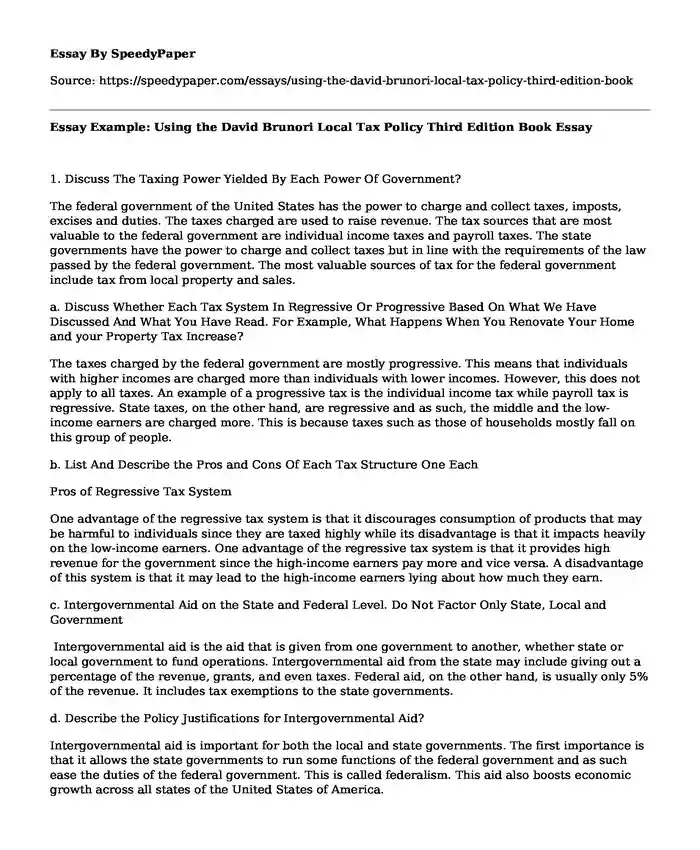
| Type of paper: | Essay |
| Categories: | Policy Tax system Government |
| Pages: | 4 |
| Wordcount: | 857 words |
1. Discuss The Taxing Power Yielded By Each Power Of Government?
The federal government of the United States has the power to charge and collect taxes, imposts, excises and duties. The taxes charged are used to raise revenue. The tax sources that are most valuable to the federal government are individual income taxes and payroll taxes. The state governments have the power to charge and collect taxes but in line with the requirements of the law passed by the federal government. The most valuable sources of tax for the federal government include tax from local property and sales.
a. Discuss Whether Each Tax System In Regressive Or Progressive Based On What We Have Discussed And What You Have Read. For Example, What Happens When You Renovate Your Home and your Property Tax Increase?
The taxes charged by the federal government are mostly progressive. This means that individuals with higher incomes are charged more than individuals with lower incomes. However, this does not apply to all taxes. An example of a progressive tax is the individual income tax while payroll tax is regressive. State taxes, on the other hand, are regressive and as such, the middle and the low-income earners are charged more. This is because taxes such as those of households mostly fall on this group of people.
b. List And Describe the Pros and Cons Of Each Tax Structure One Each
Pros of Regressive Tax System
One advantage of the regressive tax system is that it discourages consumption of products that may be harmful to individuals since they are taxed highly while its disadvantage is that it impacts heavily on the low-income earners. One advantage of the regressive tax system is that it provides high revenue for the government since the high-income earners pay more and vice versa. A disadvantage of this system is that it may lead to the high-income earners lying about how much they earn.
c. Intergovernmental Aid on the State and Federal Level. Do Not Factor Only State, Local and Government
Intergovernmental aid is the aid that is given from one government to another, whether state or local government to fund operations. Intergovernmental aid from the state may include giving out a percentage of the revenue, grants, and even taxes. Federal aid, on the other hand, is usually only 5% of the revenue. It includes tax exemptions to the state governments.
d. Describe the Policy Justifications for Intergovernmental Aid?
Intergovernmental aid is important for both the local and state governments. The first importance is that it allows the state governments to run some functions of the federal government and as such ease the duties of the federal government. This is called federalism. This aid also boosts economic growth across all states of the United States of America.
e. Describe and Explain the Concept of Fiscal Federalism?
Fiscal federalism is basically how the different functions of the government are divided between the different states. In fiscal federalism, the federal government has the power to oversee the duties of the state governments. Therefore, the federal government stabilizes the economy and distributes income while the state governments allocate resources.
f. Discuss the Pros and Cons of Intergovernmental Aid.
The first advantage of intergovernmental aid is that it enables governments to receive a good amount of money important for its functions. Secondly, it shows the accountability levels of the government. The first disadvantage is that takes time and skills to apply for a grant which may be wasted if the grant is declined. The second disadvantage is that it is highly competitive.
g. Incorporate the Concept and Techniques of Lobbying and Describe Its Relation to Intergovernmental Aid. Using Issues that Happen Such as Hurricane Sandy how to Lobby for Aid
Lobbying is a form of intergovernmental aid. It is a process in which the lower governments influence, the higher governments to receive funding. Lobbying is normally done in the case of emergencies such as the Hurricane Sandy. During the Hurricane Sandy in the Northeast, lobbying was done to receive funding for recovery, and a lot of money was used in hiring lobbyists.
h. List and Describe other Sources of Non-Tax Revenue Options and Explain Why These Revenue Forms are Necessary
The first source of non-tax revenue comes from penalties, fees, and fines. These are charged on different issues such as renewal of license or charging of parking fees. The second source is rent which is charged on buildings and other facilities. The third one comes from investments which earn interests. All these non-tax revenues increase the government's income.
i. Describe the Impact Globalization Plays on Local Tax Revenue using Example Such as Amazon.Com Company Being Local And More Convenient and how the Most States Were Willing to Pay to Have Amazon in their State
Globalization refers to the integration of people, companies, and governments among others. For example, Amazon can set up its offices in different places to sell its goods and services. The impact of this on taxation is that it reduces the taxes that are collected by the government in these states and as such individual income increases.
Cite this page
Essay Example: Using the David Brunori Local Tax Policy Third Edition Book. (2017, Aug 25). Retrieved from https://speedypaper.net/essays/using-the-david-brunori-local-tax-policy-third-edition-book
Request Removal
If you are the original author of this essay and no longer wish to have it published on the SpeedyPaper website, please click below to request its removal:
- Samsung - Global Learning Team Case. Free Essay.
- Essay Sample on Cultural Values of Early Republic
- Essay Sample on Washing Machine Invention
- Annotated Bibliography Example Dedicated to Colonial America
- Free Essay: Patients with EVD Should Not Receive Cardiopulmonary Resuscitation
- US History Essay Example
- Free Paper Sample with the Investigation of Biblical Text
Popular categories




